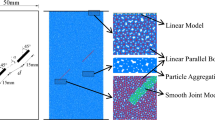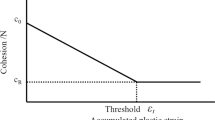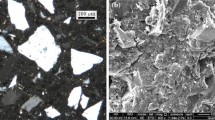Abstract
This paper aims to study the fracture characteristics of blunt indenter impacting formation under static and harmonic dynamic loads by carrying out a series of FE numerical simulations. The methodology of globally embedding cohesive elements with zero-thickness is introduced based on its constitutive response. Subsequently, the secondary development of FE simulation is carried out, and the 3D simulation of random initiation and propagation of formation without preset crack under compressive loads is realized. Two key parameters (amplitude and frequency) of dynamic load are considered, three fracture characteristic parameters (crack element number, crack area and crack volume) of formation are discussed, and the process and morphology of formation fracture and the impact velocity and displacement of blunt indenter under static–dynamic loads are investigated, respectively. Based on the analysis undertaken, it can be concluded that the harmonic dynamic load can promote crack propagation and connection. The amplitude of harmonic dynamic load is beneficial to the formation fracture, and the influence of loading frequency on it still needs to be further discussed. The impact velocity of blunt indenter changes in a harmonic form and the impact displacement increases in a fluctuating form under static–dynamic loads. The research results are of great significance for optimizing drilling parameters and designing speed-increasing tools.
Highlights
-
The methodology of globally embedding cohesive element with zero-thickness is introduced based on constitutive response.
-
The secondary development of FE simulation is conducted, which can realize random initiation and propagation of formation without preset crack under compressive loads and extract fracture characteristic parameters.
-
The 3D simulation model of blunt indenter impacting formation is proposed and the fracture process of formation under static and static-dynamic loads is compared.
-
Two key parameters (amplitude and frequency) of harmonic dynamic load are considered and three fracture characteristic parameters (crack element number, crack area and crack volume) of formation are discussed.
-
The process and morphology of formation fracture and the impact velocity and displacement of blunt indenter under static-dynamic loads are investigated.














Similar content being viewed by others
Data availability
The data presented in this study are available on request from the corresponding author.
References
Aguiar RR, Weber HI (2011) Mathematical modeling and experimental investigation of an embedded vibro-impact system. Nonlinear Dynam 65(3):317–334
Alam MR, Swamidas ASJ, Munaswamy K (2007) Experimental and numerical studies on dynamic crack growth in layered slate rock under wedge impact loads: part I—plane strain problem. Fatigue Fract Eng M 0(9):844–862
Al-Mukhtar AM, Merkel B (2015) Simulation of the crack propagation in rocks using fracture mechanics approach. J Fail Anal Preven 15:90–100
Alneasan M, Behnia M, Bagherpour R (2018) Frictional crack initiation and propagation in rocks under compressive loading. Theor Appl Fract Mec 97:189–203
Chen L, Rabczuk T, Bordas S et al (2012) Extended finite element method with edge-based strain smoothing (ESm-XFEM) for linear elastic crack growth. Comput Methods Appl Mech Eng 209:250–265
Dean J, Clyne TW (2017) Extraction of plasticity parameters from a single test using a spherical indenter and FEM modeling. Mech Mater 105:112–122
Dong G, Chen P (2018) 3D numerical simulation and experiment validation of dynamic damage characteristics of anisotropic shale for percussive-rotary drilling with a full-scale PDC bit. Energies 11(6):1326
Dong W, Yang D, Zhou X et al (2017) Experimental and numerical investigations on fracture process zone of rock–concrete interface. Fatigue Fract Eng M 40(5):820–835
Fakhimi A, Lanari M (2014) DEM-SPH simulation of rock blasting. Comput Geotech 55:158–164
Feng XT, Ding W (2007) Experimental study of limestone micro-fracturing under a coupled stress, fluid flow and changing chemical environment. Int J Rock Mech Min Sci 44(3):437–448
Feng Y, Zhang T (2015) Determination of fracture toughness of brittle materials by indentation. Acta Mech Solida Sin 28(3):221–234
González JM, Zárate F, Oñate E (2018) Pulse fracture simulation in shale rock reservoirs: DEM and FEM–DEM approaches. Comput Part Mech 5:355–373
Haeri H, Shahriar K, Marji MF et al (2014) Experimental and numerical study of crack propagation and coalescence in pre-cracked rock-like disks. Int J Rock Mech Min 67:20–28
Haeri H, Sarfarazi V, Ebneabbasi P et al (2019) XFEM and experimental simulation of failure mechanism of non-persistent joints in mortar under compression. Constr Build Mater 236:117500
Hoek E, Martin CD (2014) Fracture initiation and propagation in intact rock—a review. J Rock Mech Geotech Eng 6(4):287–300
Jiang H, Meng D (2018) 3D numerical modelling of rock fracture with a hybrid finite and cohesive element method. Eng Fract Mech 199:280–293
Ke CK, Chen CS, Ku CY et al (2009) Modeling crack propagation path of anisotropic rocks using boundary element method. Int J Numer Anal Met 33(9):1227–1253
Kitamura M, Hirose T (2017) Strength determination of rocks by using indentation tests with a spherical indenter. J Struct Geol 98:1–11
Lak M, Marji MF, Bafghi AY, Abdollahipour A (2019a) Analytical and numerical modeling of rock blasting operations using a two-dimensional elasto-dynamic Green’s function. Int J Rock Mech Min 114:208–217
Lak M, Marji MF, Bafghi AY, Abdollahipour A (2019b) A coupled finite difference-boundary element method for modeling the propagation of explosion-induced radial cracks around a well bore. J Nat Gas Sci Eng 64(1):41–45
Lanaro F, Sato T, Stephansson O (2009) Microcrack modelling of Brazilian tensile tests with the boundary element method. Int J Rock Mech Min 46(3):450–461
Lee JH, Gao YF, Johanns KE et al (2012) Cohesive interface simulations of indentation cracking as a fracture toughness measurement method for brittle materials. Acta Mater 60(15):5448–5467
Lens LN, Bittencourt E, D’Avila VMR (2009) Constitutive models for cohesive zones in mixed- mode fracture of plain concrete. Eng Fract Mech 76(14):2281–2297
Li H, Wong LNY (2012) Influence of flaw inclination angle and loading condition on crack initiation and propagation. Int J Solids Struct 49(18):2482–2499
Li W, Yan T, Li SQ (2013) Rock fragmentation mechanisms and an experimental study of drilling tools during high-frequency harmonic vibration. Petrol Sci 10:205–211
Li SQ, Yan T, Li W et al (2015) Modeling of vibration response of rock by harmonic impact. J Nat Gas Sci Eng 23:90–96
Li HS, Liu SY, Xu PP (2019) Numerical simulation on interaction stress analysis of rock with conical picks. Tunn Undergr Sp Tech 85:231–242
Li SQ, Vaziri V, Kapitaniak M et al (2020) Application of resonance enhanced drilling to coring. J Petrol Sci Eng 188:106866
Liu E, Huang R, He S (2012) Effects of frequency on the dynamic properties of intact rock samples subjected to cyclic loading under confining pressure conditions. Rock Mech Rock Eng 45(1):89–102
Liu W, Qian X, Li T et al (2019) Investigation of the tool-rock interaction using Drucker-Prager failure criterion. J Petrol Sci Eng 173:269–278
Ma L, Yari N, Wiercigroch M (2018) Shear stress triggering brittle shear fracturing of rock-like materials. Int J Mech Sci 146–147:295–302
Marji MF (2015) Simulation of crack coalescence mechanism underneath single and double disc cutters by higher order displacement discontinuity method. J Cent South Univ 22(3):1045–1054
Meschke G, Dumstorff P (2007) Energy-based modeling of cohesive and cohesionless cracks via X-FEM. Comput Methods Appl Mech Eng 196(21–24):2338–2357
Motamedi MH, Weed DA, Foster CD (2016) Numerical simulation of mixed mode (I and II) fracture behavior of pre-cracked rock using the strong discontinuity approach. Int J Solids Struct 85–86:44–56
Paliwal B, Ramesh KT (2008) An interacting micro-crack damage model for failure of brittle materials under compression. J Mech Phys Solids 56:896–923
Park K, Paulino G (2013) Cohesive zone models: a critical review of traction-separation relationships across fracture surfaces. Appl Mech Rev 64(6):060802. https://doi.org/10.1115/1.4023110
Pavlovskaia E, Hendry DC, Wiercigroch M (2015) Modelling of high frequency vibro-impact drilling. Int J Mech Sci 91:110–119
Saksala T (2010) Damage-viscoplastic consistency model with a parabolic cap for rocks with brittle and ductile behavior under low-velocity impact loading. Int J Numer Anal Meth Geomech 34(13):1362–1386
Sancho JM, Planas J, Galves JC et al (2006) An embedded cohesive crack model for finite element analysis of mixed mode fracture of concrete. Fatigue Fract Eng Mater Struct 29(12):1056–1065
Shen B, Siren T, Rinne M (2015) Modelling fracture propagation in anisotropic rock mass. Rock Mech Rock Eng 48(3):1067–1081
Wang SY, Sloan W, Liu HY et al (2011) Numerical simulation of the rock fragmentation process induced by two drill bits subjected to static and dynamic (impact) loading. Rock Mech Rock Eng 44(3):317–332
Wang S, Li X, Du K et al (2018) Experimental investigation of hard rock fragmentation using a conical pick on true triaxial test apparatus. Tunn Undergr Sp Tech 79:210–223
Wiercigroch M (2007) Resonance enhanced drilling: method and apparatus. Patent No WO 2007141550
Wiercigroch M, Vaziri V, Kapitaniak M (2017) RED: Revolutionary drilling technology for hard rock formations. SPE/IADC Drilling Conference, Proceedings 1234–1241
Wu JY, Li FB, Xu SL (2015) Extended embedded finite elements with continuous displacement jumps for the modeling of localized failure in solids. Comput Meth Appl Mech Eng 285:346–378
Zhao Z (2013) Gouge particle evolution in a rock fracture undergoing shear: a microscopic DEM study. Rock Mech Rock Eng 46(6):1461–1479
Zhou XP, Cheng H, Feng YF (2014) An experimental study of crack coalescence behaviour in rock-like materials containing multiple flaws under uniaxial compression. Rock Mech Rock Eng 47:1961–1986
Acknowledgements
The authors would like to acknowledge the support of Funding Project of Overseas Returnees and Youth Innovative Talent Cultivation Program (UNPYSCT-2020151) of Heilongjiang Province, Funds for Reform and Development from Central Government and Postdoctoral Special Funding Project of Heilongjiang Province (LBH-TZ2101).
Author information
Authors and Affiliations
Corresponding author
Additional information
Publisher's Note
Springer Nature remains neutral with regard to jurisdictional claims in published maps and institutional affiliations.
Rights and permissions
Springer Nature or its licensor (e.g. a society or other partner) holds exclusive rights to this article under a publishing agreement with the author(s) or other rightsholder(s); author self-archiving of the accepted manuscript version of this article is solely governed by the terms of such publishing agreement and applicable law.
About this article
Cite this article
Li, S., Chen, Z., Li, W. et al. An FE Simulation of the Fracture Characteristics of Blunt Rock Indenter Under Static and Harmonic Dynamic Loadings Using Cohesive Elements. Rock Mech Rock Eng 56, 2935–2947 (2023). https://doi.org/10.1007/s00603-022-03214-x
Received:
Accepted:
Published:
Issue Date:
DOI: https://doi.org/10.1007/s00603-022-03214-x




